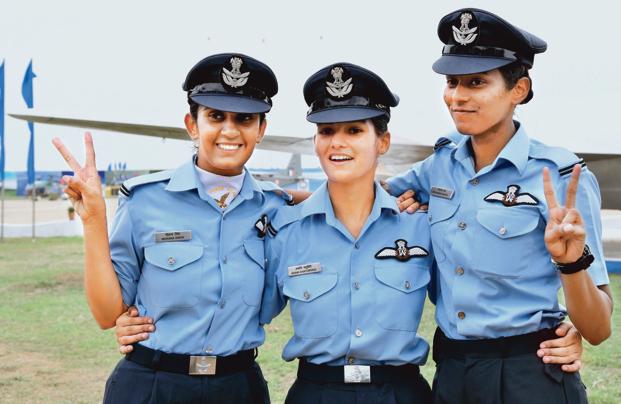On 18th July 2016, Mohana Singh, Bhawana Kanth and Avani Chaturvedi created history by being admitted in the Indian Armed Forces (IAF) Fighter Squadron.
This was the first time ever that women were permitted in combat roles. The trio have become an inspiration for all the women in our country by entering into a job that is reserved for men, thereby breaking rigid gender barriers.
From JhunJhunu, Rajasthan, we have Mohana Singh who was inspired by her grandfather, an ex-Flight Gunner in the Aviation Research Centre and her father who is a Warrant officer in the IAF. She decided to continue the family legacy of serving in the armed forces.
Next is Avani Chaturvedi from Madhya Pradesh who got inspiration from her brother, currently serving in the army. Her dream was to always conquer the skies and thus, joined the Flying Club in her college.
The trio have become an inspiration for women by entering into a job that is reserved for men.
The last of the trio is the dreamer Bhawna Kanth, who hails from the city of Darbhanga in the Indian state of Bihar. As a child, she always dreamt of flying planes and opted for the Fighter stream after her stage one training.
The three brilliant pilots were commissioned as Flying Officers and received their coveted wings, from the then Union Minister for Defense, Manohar Parrikar.
On October 2015, Government of India opened up this fighting stream for women on an experimental basis of five years. Three women from out of a batch of 125 were selected. They have been undergoing an intense training from 4 am to 10 pm to become the first fighter pilots.
At training, the three women have mostly operated easier-to-handle aircrafts like Kiran, PC-7 turboprops and Hawk Jet Trainers. But, now, they are going to operate Mikoyan-Gurevich 21 (MiG 21) – the fastest planes in the world with landing and taking off speed at 340 kilometres per hour. Designed by Russia, they are supersonic jets and interceptors, on which these Indian women have flown – for the first time ever.
In an interview, a senior officer told TOI that,
“Avani is already undertaking sorties in a twin-seat MiG-21 Type 69 trainer with a qualified fighter instructor (QFI) at the Suratgarh airbase. Bhawana will follow suit at the Ambala airbase soon. Mohana, in turn, is still with Hawk advanced jet trainers at the Kalaikunda airbase. She will also be posted to an operational squadron in due course.”
Also Read: Aditi Ashok: A Reminder Why Golf Is Not Just A Man’s Sport
But flying this jet is exceptionally demanding and difficult.
So, a rookie fighter pilot goes through dozens of “dual check” sorties. There they are taught basic take-off and landing, flying techniques and handling before actually being considered as fit for solo sorties by the QFIs. Just by flying solo jets, they do not immediately become complete fighter pilots who can handle the intricacies of high-voltage combat flying.
Soon after consolidating their general handling of MiG-21 in solo sorties, they will qualify for calculated flying and manoeuvers. This will be followed by air-to-air and air-to-ground combat training. The last step is to become “fully ops” (operational) by the day on the MiG-21. Post this, they can start night flying first in the ‘moon phase’ and then the ‘dark phase’.
The officer stated that “A fighter pilot is declared ‘fully ops’ only after successfully undergoing this entire process, which takes upwards of a year”.
There are several challenges. The long-standing exclusion policy of women from the Indian Armed Forces. There is a notion that including women fighter pilots can disturb ‘tight fighter-flying schedules’ once they get married and have children.
It is thought that once women reach the age of 23, they will soon get married, have children and give time to family life which would keep them from flying for some time. Many, have advised the trio to delay motherhood for at least four years. This was to ensure that their training can proceed easily.
There is a notion that including women fighter pilots can disturb ‘tight fighter-flying schedules’ once they get married and have children.
Another issue is that women could be forced to eject over enemy territory. In response to it, Parrikar once stated that, “No. Think of what can happen if a woman is taken as a prisoner in a combat operation.”
Since long IAF has had reservations against female fighter pilots. Arup Raha, the Chief Marshal said that “As far as flying fighter planes are concerned, it is a very challenging job. Women by nature are not physically suited for flying fighter planes for long hours, especially when they are pregnant or have other health problems”.
Many people also feel that because women are involved there is some sort of favouritism. But the reality is that Avani and Bhawana were not given easy-to-handle fighter plans like Mirage – the 2000s, and 30MKIs. Rather, they were given Mig-21 squadrons – which was the most difficult to handle.
By entering the defence squadron, the trio have become risk-takers who are challenging the conventional standards of macho masculinity. Now, by soon flying the supersonic jet fighter they have proved that the sky is the limit for them. We hope that they continue to achieve even greater feats in the future.
Also Read: Arunima Sinha And The Life Lessons She Can Teach Us
Featured Image Credit: Livemint
About the author(s)
Sahima Gupta is a second-year student, majoring in Political Science. She is a bibliophile who has a keen interest in history, travel, and photography.




